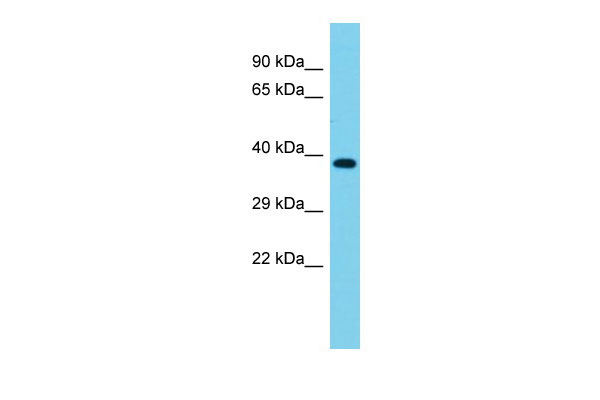SDCCAG3 Antibody - C-terminal region
Rabbit Polyclonal Antibody
- SPECIFICATION
- CITATIONS
- PROTOCOLS
- BACKGROUND

Application
| WB |
|---|---|
| Primary Accession | Q96C92 |
| Other Accession | NM_006643, NP_006634 |
| Reactivity | Human, Mouse, Rat, Rabbit, Horse, Bovine, Guinea Pig, Dog |
| Predicted | Human, Mouse, Rat, Rabbit, Pig, Horse, Bovine, Guinea Pig, Dog |
| Host | Rabbit |
| Clonality | Polyclonal |
| Calculated MW | 39kDa |
| Gene ID | 10807 |
|---|---|
| Alias Symbol | NY-CO-3 |
| Other Names | Serologically defined colon cancer antigen 3, Antigen NY-CO-3, SDCCAG3 |
| Format | Liquid. Purified antibody supplied in 1x PBS buffer with 0.09% (w/v) sodium azide and 2% sucrose. |
| Reconstitution & Storage | Add 50 ul of distilled water. Final anti-SDCCAG3 antibody concentration is 1 mg/ml in PBS buffer with 2% sucrose. For longer periods of storage, store at 20°C. Avoid repeat freeze-thaw cycles. |
| Precautions | SDCCAG3 Antibody - C-terminal region is for research use only and not for use in diagnostic or therapeutic procedures. |
| Name | ENTR1 (HGNC:10667) |
|---|---|
| Synonyms | SDCCAG3 |
| Function | Endosome-associated protein that plays a role in membrane receptor sorting, cytokinesis and ciliogenesis (PubMed:23108400, PubMed:25278552, PubMed:27767179). Involved in the endosome-to-plasma membrane trafficking and recycling of SNX27-retromer-dependent cargo proteins, such as GLUT1 (PubMed:25278552). Involved in the regulation of cytokinesis; the function may involve PTPN13 and GIT1 (PubMed:23108400). Plays a role in the formation of cilia (PubMed:27767179). Involved in cargo protein localization, such as PKD2, at primary cilia (PubMed:27767179). Involved in the presentation of the tumor necrosis factor (TNF) receptor TNFRSF1A on the cell surface, and hence in the modulation of the TNF-induced apoptosis (By similarity). |
| Cellular Location | Cytoplasm {ECO:0000250|UniProtKB:A2AIW0}. Early endosome. Endosome. Recycling endosome. Midbody Cytoplasm, cytoskeleton, microtubule organizing center, centrosome. Cytoplasm, cytoskeleton, cilium basal body Note=Colocalizes in a WASHC2-dependent manner with the retromer CSC complex at endosomes (PubMed:25278552). During cytokinesis colocalized with PTPN13 at the midbody (PubMed:23108400). Colocalizes with IFT88 and gamma-tubulin at the basal body of primary cilia (PubMed:27767179) Colocalizes with IFT88 and pericentrin at the centrosome (PubMed:27767179). |
| Tissue Location | Expressed in the colon (at protein level). |

Thousands of laboratories across the world have published research that depended on the performance of antibodies from Abcepta to advance their research. Check out links to articles that cite our products in major peer-reviewed journals, organized by research category.
info@abcepta.com, and receive a free "I Love Antibodies" mug.
Provided below are standard protocols that you may find useful for product applications.
If you have used an Abcepta product and would like to share how it has performed, please click on the "Submit Review" button and provide the requested information. Our staff will examine and post your review and contact you if needed.
If you have any additional inquiries please email technical services at tech@abcepta.com.













 Foundational characteristics of cancer include proliferation, angiogenesis, migration, evasion of apoptosis, and cellular immortality. Find key markers for these cellular processes and antibodies to detect them.
Foundational characteristics of cancer include proliferation, angiogenesis, migration, evasion of apoptosis, and cellular immortality. Find key markers for these cellular processes and antibodies to detect them. The SUMOplot™ Analysis Program predicts and scores sumoylation sites in your protein. SUMOylation is a post-translational modification involved in various cellular processes, such as nuclear-cytosolic transport, transcriptional regulation, apoptosis, protein stability, response to stress, and progression through the cell cycle.
The SUMOplot™ Analysis Program predicts and scores sumoylation sites in your protein. SUMOylation is a post-translational modification involved in various cellular processes, such as nuclear-cytosolic transport, transcriptional regulation, apoptosis, protein stability, response to stress, and progression through the cell cycle. The Autophagy Receptor Motif Plotter predicts and scores autophagy receptor binding sites in your protein. Identifying proteins connected to this pathway is critical to understanding the role of autophagy in physiological as well as pathological processes such as development, differentiation, neurodegenerative diseases, stress, infection, and cancer.
The Autophagy Receptor Motif Plotter predicts and scores autophagy receptor binding sites in your protein. Identifying proteins connected to this pathway is critical to understanding the role of autophagy in physiological as well as pathological processes such as development, differentiation, neurodegenerative diseases, stress, infection, and cancer.


